Indesit FI 56 KC.B, FI 51.B IX, FI 51 K.B, FI 56 KC.B IX, FI 51.B User Manual [it]
...
Istruzioni per l’uso
FORNO
|
|
|
|
|
|
|
|
|
|
|
|
|
|
|
|
|
Sommario |
|
|
|
|
|
|
|
|
|
IT |
||
|
|
|
|
|
|
|
|
|
|
|
|
|
|
|
|
|
Installazione, 2-3 |
|
|
|
IT |
|
GB |
|
FR |
|
|
||
|
|
|
|
Posizionamento |
|||||
|
|
|
|
|
|
|
Collegamento elettrico |
||
|
|
|
|
|
|
|
|||
|
Italiano, 1 |
English,12 |
Français, 22 |
Targhetta caratteristiche |
|||||
|
|
|
|
|
|
|
Descrizione dell’apparecchio, 4 |
||
|
ES |
|
PT |
|
NL |
|
|||
|
|
|
|
Vista d’insieme |
|||||
|
|
|
|
|
|
|
Pannello di controllo |
||
|
Espanol, 32 |
Portuges, 42 |
Nederlands, 52 |
||||||
|
|
|
|
||||||
|
|
|
|
|
|
|
Avvio e utilizzo, 5 |
||
|
|
|
|
|
|
|
|||
|
DE |
|
|
|
|
|
Avviare il forno |
||
|
|
|
|
|
|
|
Utilizzare il timer |
||
|
Deutsch, 62 |
|
|
|
|
Programmi, 6-7 |
|||
|
|
|
|
|
|
|
|||
|
|
|
|
|
|
|
Programmi di cottura |
||
|
|
|
|
|
|
|
Consigli pratici di cottura |
||
|
|
|
|
|
|
|
Tabella cottura |
||
FI 51.B FI 51.B IX FI 51 K.B
FI 51 K.B IX FI 56 K.B FI 56 K.B IX FI 56 KC.B
FI 56 KC.B IX
Il programmmatore di cottura elettronico, 8
Precauzioni e consigli, 9
Sicurezza generale Smaltimento
Risparmiare e rispettare l’ambiente
Manutenzione e cura, 10
Escludere la corrente elettrica Pulire l’apparecchio
Pulire la porta Sostituire la lampadina
Assistenza, 11
Assistenza attiva 7 giorni su 7
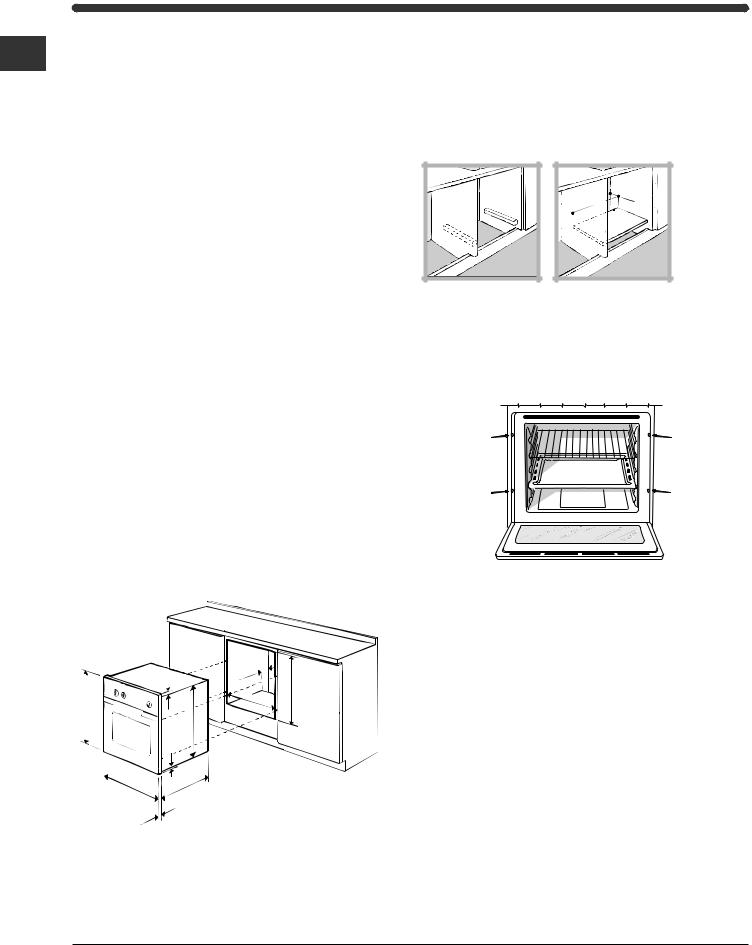
Installazione
! È importante conservare questo libretto per poterlo IT consultare in ogni momento. In caso di vendita, di
cessione o di trasloco, assicurarsi che resti insieme all’apparecchio per informare il nuovo proprietario sul funzionamento e sui relativi avvertimenti.
! Leggere attentamente le istruzioni: ci sono importanti informazioni sull’installazione, sull’uso e sulla sicurezza.
Posizionamento
!Gli imballaggi non sono giocattoli per bambini e vanno eliminati secondo le norme per la raccolta differenziata (vedi Precauzioni e consigli).
!L’installazione va effettuata secondo queste istruzioni e da personale professionalmente qualificato. Una errata installazione può causare danni a persone, animali o cose.
Incasso
Per garantire un buon funzionamento dell’apparecchio è necessario che il mobile abbia le caratteristiche adatte:
•i pannelli adiacenti il forno devono essere di materiale resistente al calore;
•nel caso di mobili in legno impiallacciato, le colle devono essere resistenti alla temperatura di 100°C;
•per l’incasso del forno, sia nel caso di inserimento sottotavolo (vedi figura) che a colonna, il mobile deve avere le seguenti dimensioni:
595 mm. |
23 mm. |
567 mm. |
|
|
5 mm. |
595 |
mm. |
|
. |
|
545 |
mm |
|
|
|
||
|
. |
|
|
|
mm |
|
|
24 |
|
|
|
|
|
. |
45 |
mm |
|
|
|
|
|
558 |
mm. |
|
|
|
593 mm.
! Una volta incassato l’apparecchio non debbono essere possibili contatti con le parti elettriche. Le dichiarazioni di consumo indicate in targhetta
caratteristiche sono state misurate con questo tipo di installazione.
Aerazione
Per garantire una buona aerazione è necessario eliminare la parete posteriore del vano. È preferibile installare il forno in modo che appoggi su due listelli in legno oppure su un piano continuo che abbia un’apertura di almeno 45 x 560 mm (vedi figure).
. |
45 |
mm |
. |
mm |
|
||
560 |
|
|
|
Centraggio e fissaggio
Per fissare l’apparecchio al mobile: aprire la porta del forno e avvitare 4 viti a legno nei 4 fori posti sulla cornice perimetrale.
! Tutte le parti che assicurano la protezione debbono essere fissate in modo tale da non poter essere tolte senza l’aiuto di qualche utensile.
Collegamento elettrico
! I forni dotati di cavo di alimentazione tripolare sono predisposti per il funzionamento con corrente alternata, con tensione e frequenza indicate nella targhetta caratteristiche (vedi sotto).
2
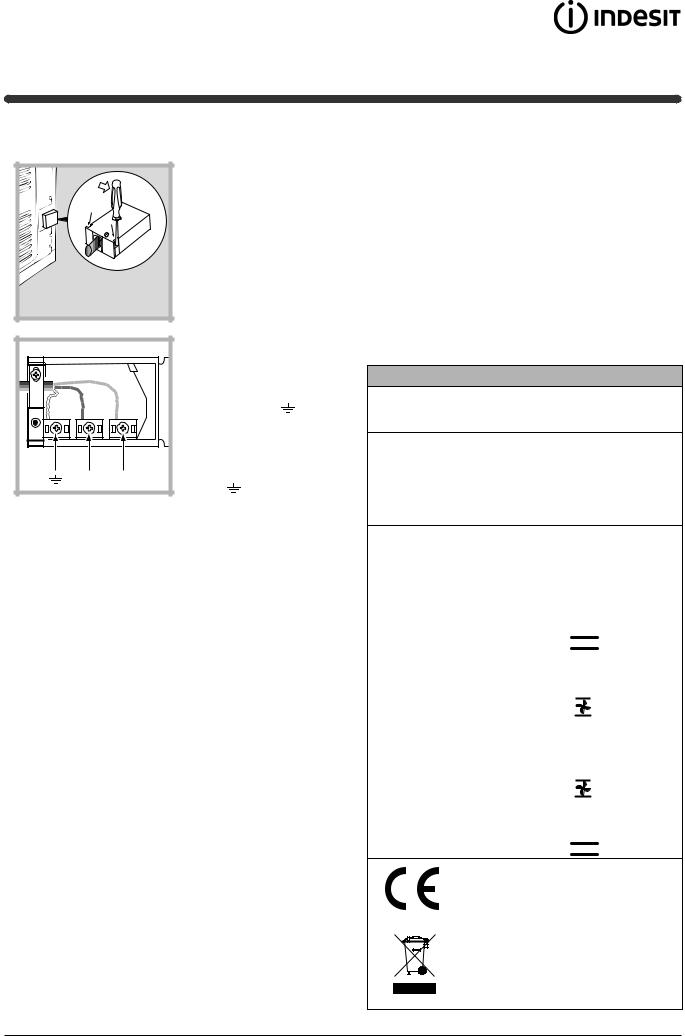
Montaggio del cavo di alimentazione
1. Aprire la morsettiera facendo leva con un cacciavite sulle linguette laterali del coperchio: tirare e aprire il coperchio (vedi figura).
|
|
2. Mettere in opera il |
||
|
|
cavo di alimentazione: |
||
|
|
svitare la vite del |
||
|
|
serracavo e le tre viti |
||
|
|
dei contatti L-N- e poi |
||
|
|
fissare i cavetti sotto |
||
|
|
le teste delle viti |
||
|
|
rispettando i colori Blu |
||
N |
L |
(N) Marrone (L) Giallo- |
||
Verde |
(vedi figura). |
|||
|
|
|||
3.Fissare il cavo nell’apposito fermacavo.
4.Chiudere il coperchio della morsettiera.
Allacciamento del cavo di alimentazione alla rete
Montare sul cavo una spina normalizzata per il carico indicato nella targhetta caratteristiche (vedi a fianco). In caso di collegamento diretto alla rete è necessario interporre tra l’apparecchio e la rete un interruttore onnipolare con apertura minima fra i contatti di 3 mm dimensionato al carico e rispondente alle norme in vigore (il filo di terra non deve essere interrotto dall’interruttore). Il cavo di alimentazione deve essere posizionato in modo tale che in nessun punto superi di 50°C la temperatura ambiente.
! L’installatore è responsabile del corretto collegamento elettrico e dell’osservanza delle norme di sicurezza.
Prima di effettuare l’allacciamento accertarsi che:
•la presa abbia la messa a terra e sia a norma di legge;
•la presa sia in grado di sopportare il carico massimo di potenza della macchina, indicato nella targhetta caratteristiche (vedi sotto);
•la tensione di alimentazione sia compresa nei valori nella targhetta caratteristiche (vedi sotto);
• la presa sia compatibile con la spina |
|
|
IT |
||
dell’apparecchio. In caso contrario sostituire la |
||
|
||
presa o la spina; non usare prolunghe e multiple. |
|
|
|
!Ad apparecchio installato, il cavo elettrico e la presa della corrente devono essere facilmente raggiungibili.
!Il cavo non deve subire piegature o compressioni.
!Il cavo deve essere controllato periodicamente e sostituito solo da tecnici autorizzati (vedi Assistenza).
!L’azienda declina ogni responsabilità qualora queste norme non vengano rispettate.
TARGHETTA CARATTERISTICHE
larghezza cm 43,5 Dimensioni altezza cm 32
profondità cm 40
Volume |
lt. 56 |
|
|
|
|
|
tensione a 220-230V ~ 50/60Hz o |
|
Collegamenti |
50Hz (vedi targhetta |
|
caratteristiche) |
||
elettrici |
||
potenza massima assorbita |
||
|
||
|
2250W |
Direttiva 2002/40/CE sull’etichetta dei forni elettrici. Norma EN 50304
Modelli con ventilazione di
raffreddamento:
Consumo energia convezione Naturale – funzione di riscaldamento: Tradizionale;
|
Consumo energia dichiarazione |
||
ENERGY |
Classe convezione Forzata - |
||
funzione di |
|
||
LABEL |
|
||
riscaldamento: |
Multicottura. |
||
|
|||
Modelli senza ventilazione di
raffreddamento: |
|
Consumo energia convezione |
|
Forzata – funzione di |
|
riscaldamento: |
Multicottura; |
Consumo energia dichiarazione Classe convezione Naturale - funzione di
riscaldamento: Tradizionale.
Questa apparecchiatura è conforme alle seguenti Direttive Comunitarie: 73/23/CEE del 19/02/73 (Bassa Tensione) e successive modificazioni - 89/336/CEE del 03/05/89 (Compatibilità Elettromagnetica) e successive modificazioni - 93/68/CEE del 22/07/93 e successive modificazioni. 2002/96/CE
3
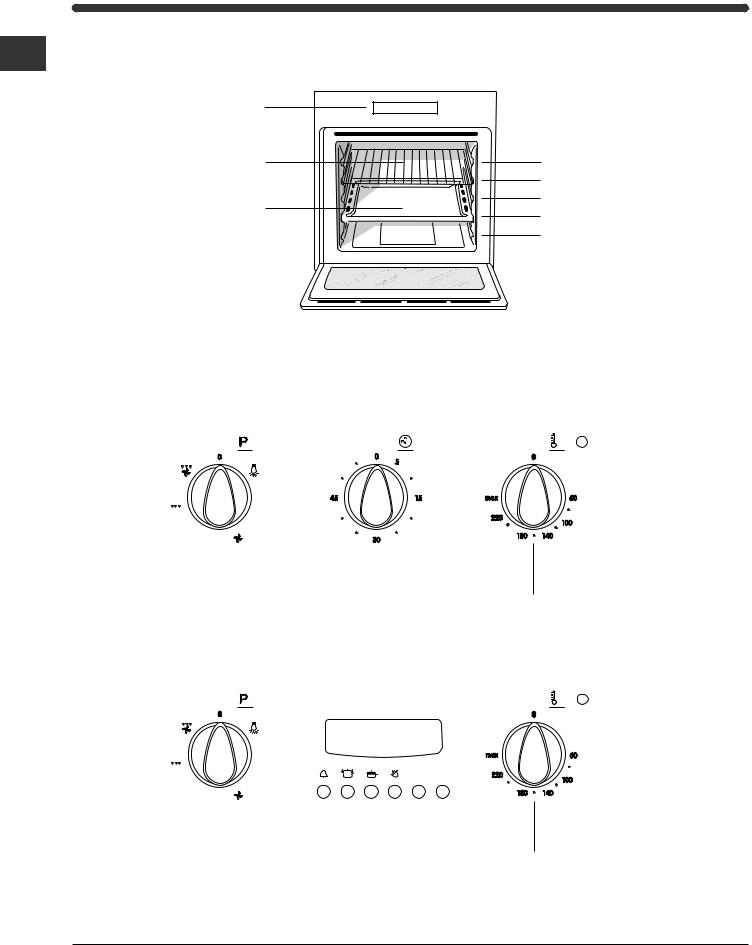
Descrizione |
|
|
dell’apparecchio |
|
|
Vista d’insieme |
|
|
IT |
|
|
Pannello di controllo |
GUIDE |
|
|
di scorrimento |
|
|
dei ripiani |
|
Ripiano GRIGLIA |
posizione 5 |
|
|
posizione 4 |
|
Ripiano LECCARDA |
posizione 3 |
|
posizione 2 |
||
|
||
|
posizione 1 |
Pannello di controllo
|
|
|
|
|
|
|
Manopola |
|
Manopola |
|
|
|
|
Spia |
|
|
||||||||||
|
|
|
|
|
|
|
|
|
|
|
|
|
||||||||||||||
|
|
|
|
|
|
|
PROGRAMMI |
|
TIMER* |
TERMOSTATO |
|
|
||||||||||||||
|
|
|
|
|
|
|
|
|
|
|
|
|
|
|
|
|
|
|
|
|
|
|
|
|
|
|
|
|
|
|
|
|
|
|
|
|
|
|
|
|
|
|
|
|
|
|
|
|
|
|
|
|
|
|
|
|
|
|
|
|
|
|
|
|
|
|
|
|
|
|
|
|
|
|
|
|
|
|
|
|
|
|
|
|
|
|
|
|
|
|
|
|
|
|
|
|
|
|
|
|
|
|
|
|
|
|
|
|
|
|
|
|
|
|
|
|
|
|
|
|
|
|
|
|
|
|
|
|
|
|
|
|
|
|
|
|
|
|
|
|
|
|
|
|
|
|
|
|
|
|
|
|
|
|
|
|
|
|
|
|
|
|
|
|
|
|
|
|
|
|
|
|
|
|
|
|
|
|
|
|
|
|
|
|
|
|
|
|
|
|
|
|
|
|
|
|
|
|
|
|
|
|
|
|
|
|
|
|
|
|
|
|
|
|
|
|
|
|
|
|
|
|
|
|
|
|
|
|
|
|
|
|
|
|
|
|
|
|
|
|
|
|
|
|
|
|
|
|
|
|
|
|
|
|
|
|
|
|
|
|
|
|
|
|
|
|
|
|
|
|
|
|
|
|
|
|
|
|
|
|
|
|
|
|
|
|
|
|
|
|
|
|
|
|
|
|
|
|
|
|
|
|
|
|
|
|
|
|
|
|
|
|
|
|
|
|
|
|
|
|
|
|
|
|
|
|
|
|
|
|
|
|
|
|
|
|
|
|
|
|
|
|
|
|
|
|
|
|
|
|
Manopola
TERMOSTATO
|
|
|
|
|
|
|
Manopola |
|
|
|
|
Programmatore |
|
|
|
Spia |
|
|
|||||||||||||
|
|
|
|
|
|
|
|
|
|
|
|
|
|
|
|||||||||||||||||
|
|
|
|
|
|
|
PROGRAMMI |
|
|
|
|
ELETTRONICO* TERMOSTATO |
|
|
|||||||||||||||||
|
|
|
|
|
|
|
|
|
|
|
|
|
|
|
|
|
|
|
|
|
|
|
|
|
|
|
|
|
|
|
|
|
|
|
|
|
|
|
|
|
|
|
|
|
|
|
|
|
|
|
|
|
|
|
|
|
|
|
|
|
|
|
|
|
|
|
|
|
|
|
|
|
|
|
|
|
|
|
|
|
|
|
|
|
|
|
|
|
|
|
|
|
|
|
|
|
|
|
|
|
|
|
|
|
|
|
|
|
|
|
|
|
|
|
|
|
|
|
|
|
|
|
|
|
|
|
|
|
|
|
|
|
|
|
|
|
|
|
|
|
|
|
|
|
|
|
|
|
|
|
|
|
|
|
|
|
|
|
|
|
|
|
|
|
|
|
|
|
|
|
|
|
|
|
|
|
|
|
|
|
|
|
|
|
|
|
|
|
|
|
|
|
|
|
|
|
|
|
|
|
|
|
|
|
|
|
|
|
|
|
|
|
|
|
|
|
|
|
|
|
|
|
|
|
|
|
|
|
|
|
|
|
|
|
|
|
|
|
|
|
|
|
|
|
|
|
|
|
|
|
|
|
|
|
|
|
|
|
|
|
|
|
|
|
|
|
|
|
|
|
|
|
|
|
|
|
|
|
|
|
|
|
|
|
|
|
|
|
|
|
|
|
|
|
|
|
|
|
|
|
|
|
|
|
|
|
|
|
|
|
|
|
|
|
|
|
|
|
|
|
|
|
|
|
|
|
|
|
|
|
|
|
|
|
|
|
|
|
|
|
|
|
|
|
|
|
|
|
|
|
|
|
|
|
|
|
|
|
|
|
|
|
|
|
|
|
|
|
|
|
|
|
|
|
|
|
|
|
|
|
|
|
|
Manopola
TERMOSTATO
* Presente solo in alcuni modelli.
4

Avvio e utilizzo
! Alla prima accensione fare funzionare il forno a vuoto per almeno un’ora con il termostato al massimo e a porta chiusa. Poi spegnere, aprire la porta del forno
e aerare il locale. L’odore che si avverte è dovuto all’evaporazione delle sostanze usate per proteggere il forno.
Avviare il forno
1.Selezionare il programma di cottura desiderato ruotando la manopola PROGRAMMI.
2.Scegliere la temperatura ruotando la manopola TERMOSTATO. Una lista con le cotture e le relative temperature consigliate è consultabile nella Tabella cottura (vedi Programmi).
3.La spia TERMOSTATO accesa indica la fase di riscaldamento fino alla temperatura impostata.
4.Durante la cottura è sempre possibile:
-modificare il programma di cottura agendo sulla manopola PROGRAMMI;
-modificare la temperatura agendo sulla manopola TERMOSTATO;
-interrompere la cottura riportando la manopola PROGRAMMI in posizione “0”.
! Negli apparecchi dotati di programmatore elettronico per utilizzare il forno elettrico premere il tasto (sul display compare il simbolo m) prima di selezionare la funzione di cottura desiderata.
!Non appoggiare mai oggetti sul fondo del forno perché si rischiano danni allo smalto.
!Porre sempre i recipienti di cottura sulla griglia in dotazione.
Ventilazione di raffreddamento
IT
Per ottenere una riduzione delle temperature esterne, alcuni modelli sono dotati di una ventola di raffreddamento. Questa genera un getto d’aria che esce tra il pannello di controllo e la porta del forno.
! A fine cottura la ventola rimane attiva finché il forno non è sufficientemente freddo.
Luce del forno
Si accende selezionando  con la manopola PROGRAMMI. Rimane accesa quando si seleziona un programma di cottura.
con la manopola PROGRAMMI. Rimane accesa quando si seleziona un programma di cottura.
Utilizzare il timer*
1.Occorre anzitutto caricare la suoneria, ruotando la manopola TIMER di un giro quasi completo in senso orario.
2.Tornando indietro in senso antiorario, impostare il tempo desiderato facendo coincidere i minuti indicati sulla manopola TIMER con il riferimento fisso sul pannello di controllo.
3.Il timer è un contaminuti: a tempo scaduto emette un segnale acustico.
! Il timer non controlla l’accensione e lo spegnimento del forno.
* Presente solo in alcuni modelli.
5
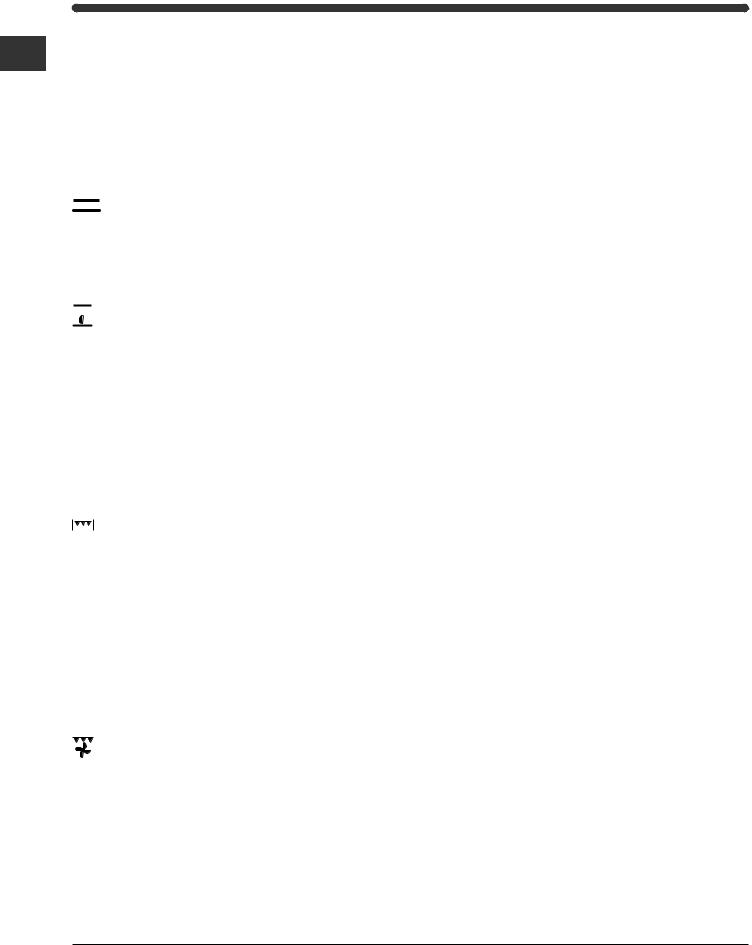
Programmi
Programmi di cottura
IT
! Per tutti i programmi è impostabile una temperatura tra 60°C e MAX, tranne:
•GRILL (si consiglia di impostare solo su MAX);
•GRATIN (si consiglia di non superare la temperatura di 200°C).
Programma FORNO TRADIZIONALE
Si attivano i due elementi riscaldanti inferiore e superiore. Con questa cottura tradizionale è meglio utilizzare un solo ripiano: con più ripiani si ha una cattiva distribuzione della temperatura.
 Programma MULTICOTTURA
Programma MULTICOTTURA
Si attivano tutti gli elementi riscaldanti (superiore e inferiore) ed entra in funzione la ventola. Poiché il calore è costante in tutto il forno, l’aria cuoce e rosola il cibo in modo uniforme. È possibile utilizzare fino a un massimo di due ripiani contemporaneamente.


 Programma FORNO SOPRA
Programma FORNO SOPRA
Si accende l’elemento riscaldante superiore. Questa funzione può essere utilizzata per ritocchi di cottura.
Programma GRILL
Si accende l’elemento riscaldante superiore. La temperatura assai elevata e diretta del grill consente la immediata rosolatura superficiale dei cibi che, ostacolando la fuoriuscita dei liquidi, li mantiene più teneri internamente. La cottura al grill è particolarmente consigliata per quei piatti che necessitano di elevata temperatura superficiale: bistecche di vitello e manzo, entrecôte, filetto, hamburger etc... Alcuni esempi di utilizzo sono riportati al paragrafo “Consigli pratici per la cottura”. Effettuare le cotture con la porta del forno chiusa.
Programma GRATIN
Si attiva l’elemento riscaldante superiore ed entra in funzione la ventola. Unisce all’irradiazione termica unidirezionale, la circolazione forzata dell’aria all’interno del forno. Ciò impedisce la bruciatura superficiale degli alimenti aumentando il potere di penetrazione del calore. Effettuare le cotture con la porta del forno chiusa.
Consigli pratici di cottura
!Nelle cotture ventilate non utilizzare le posizioni dei ripiani 1 e 5: sono investite direttamente dall’aria calda, che potrebbe provocare bruciature sui cibi delicati.
!Nelle cotture GRILL e GRATIN, disporre
la leccarda in posizione 1 per raccogliere i residui di cottura (sughi e/o grassi).
MULTICOTTURA
•Utilizzare le posizioni dei ripiani 2 e 4, mettendo alla 2 i cibi che richiedono maggior calore.
•Disporre la leccarda in basso e la griglia in alto. GRILL
•Inserire la griglia in posizione 3 o 4, disponendo gli alimenti al centro della griglia.
•Si consiglia di impostare il livello di energia al massimo. Non allarmarsi se la resistenza superiore non resta costantemente accesa: il suo funzionamento è controllato da un termostato.
PIZZA
•Per una buona cottura della pizza ultilizzate il programma MULTICOTTURA.
•Utilizzare una teglia in alluminio leggero, appoggiandola sulla griglia in dotazione. Con la leccarda si allungano i tempi di cottura e difficilmente si ottiene una pizza croccante.
•Nel caso di pizze molto farcite è consigliabile inserire la mozzarella a metà cottura.
6

|
|
|
|
|
|
|
|
|
|
|
|
Tabella cottura |
|
|
|
|
|
|
|
|
|
|
|
|
|
|
|
|
IT |
|||
|
|
|
|
|
|
|
|
|
|
|
|
|
|
|
|
|
|
|
|
|
|
|
|
|
Peso |
Posizione |
Preriscaldamento |
Temperatura |
Durata |
|
||
|
Programmi |
Alimenti |
cottura |
|
|
|||||
|
(Kg) |
dei ripiani |
(minuti) |
consigliata |
|
|||||
|
|
|
(minuti) |
|
|
|||||
|
|
|
|
|
|
|
|
|||
|
|
|
|
|
|
|
|
|
|
|
|
|
Anatra |
1 |
3 |
15 |
200 |
65-75 |
|
|
|
|
Forno |
Arrosto di vitello o manzo |
1 |
3 |
15 |
200 |
70-75 |
|
|
|
|
Arrosto di maiale |
1 |
3 |
15 |
200 |
70-80 |
|
|
|
|
|
Tradizionale |
|
|
|
||||||
|
Biscotti (di frolla) |
- |
3 |
15 |
180 |
15-20 |
|
|
|
|
|
|
|
|
|
||||||
|
|
Crostate |
1 |
3 |
15 |
180 |
30-35 |
|
|
|
|
|
|
|
|
|
|
|
|
|
|
|
|
Pizza (su 2 ripiani) |
1 |
2 e 4 |
15 |
230 |
15-20 |
|
|
|
|
|
Lasagne |
1 |
3 |
10 |
180 |
30-35 |
|
|
|
|
|
Agnello |
1 |
2 |
10 |
180 |
40-45 |
|
|
|
|
|
Pollo arrosto + patate |
1+1 |
2 e 4 |
15 |
200 |
60-70 |
|
|
|
|
Multicottura |
Sgombro |
1 |
2 |
10 |
180 |
30-35 |
|
|
|
|
Plum-cake |
1 |
2 |
10 |
170 |
40-50 |
|
|
|
|
|
|
Bignè (su 2 ripiani) |
0.5 |
2 e 4 |
10 |
190 |
20-25 |
|
|
|
|
|
Biscotti(su 2 ripiani) |
0.5 |
2 e 4 |
10 |
180 |
10-15 |
|
|
|
|
|
Pan di spagna (su 1 ripiano) |
0.5 |
2 |
10 |
170 |
15-20 |
|
|
|
|
|
Pan di spagna (su 2 ripiani) |
1 |
2 e 4 |
10 |
170 |
20-25 |
|
|
|
|
|
Torte salate |
1.5 |
3 |
15 |
200 |
25-30 |
|
|
|
|
|
|
|
|
|
|
|
|
|
|
|
Forno Sopra |
Ritocchi di cottura |
- |
3/4 |
15 |
220 |
- |
|
|
|
|
|
|
|
|
|
|
|
|
|
|
|
|
Sogliole e seppie |
1 |
4 |
5 |
Max |
8-10 |
|
|
|
|
|
Spiedini di calamari e gamberi |
1 |
4 |
5 |
Max |
6-8 |
|
|
|
|
|
Filetto di merluzzo |
1 |
4 |
5 |
Max |
10 |
|
|
|
|
Grill |
Verdure alla griglia |
1 |
3/4 |
5 |
Max |
10-15 |
|
|
|
|
Bistecca di vitello |
1 |
4 |
5 |
Max |
15-20 |
|
|
|
|
|
|
Cotolette |
1 |
4 |
5 |
Max |
15-20 |
|
|
|
|
|
Hamburger |
1 |
4 |
5 |
Max |
7-10 |
|
|
|
|
|
Sgombri |
1 |
4 |
5 |
Max |
15-20 |
|
|
|
|
|
Toast |
n.° 4 |
4 |
5 |
Max |
2-3 |
|
|
|
|
|
|
|
|
|
|
|
|
|
|
|
Gratin |
Pollo alla griglia |
1.5 |
2 |
5 |
200 |
55-60 |
|
|
|
|
Seppie |
1.5 |
2 |
5 |
200 |
30-35 |
|
|
|
|
|
|
|
|
|
||||||
|
|
|
|
|
|
|
|
|
|
|
7

Il programmmatore di cottura elettronico
|
Consente di programmare il forno o il grill nei |
|
|
|
||||||||||||||||||||||
IT |
|
|
|
|||||||||||||||||||||||
funzionamenti: |
|
|
|
|
|
|
|
|
|
|
||||||||||||||||
|
|
|
|
|
|
|
|
|
|
|
||||||||||||||||
|
• inizio cottura ritardato con durata stabilita; |
|
|
|
||||||||||||||||||||||
|
|
|
|
|||||||||||||||||||||||
|
• inizio immediato con durata stabilita; |
|
|
|
|
|
|
|
|
|||||||||||||||||
|
• |
|
contaminuti. |
|
|
|
|
|
|
|
|
|
|
|||||||||||||
|
Funzione dei tasti : |
|
|
|
|
|
|
|
|
|||||||||||||||||
|
|
|
|
|
|
|
: contaminuti ore, minuti |
|
|
|
|
|
|
|
|
|||||||||||
|
|
|
|
|
|
|
|
: durata cottura |
|
|
|
|
|
|
|
|
||||||||||
|
|
|
|
|
|
|
|
: fine cottura |
|
|
|
|
|
|
|
|
|
|
||||||||
|
|
|
|
|
|
|
|
|
|
|
|
|
|
|
|
|
||||||||||
|
|
|
|
|
|
|
: commutazione manuale |
|
|
|
|
|
|
|
|
|||||||||||
|
|
|
|
|
|
|
|
: impostazione tempi indietro |
|
|
|
|
|
|
|
|
||||||||||
|
|
|
|
|
|
|
: impostazione tempi avanti |
|
|
|
|
|
|
|
|
|||||||||||
|
Come rimettere l’orologio digitale |
|
|
|
|
|
|
|
|
|||||||||||||||||
|
Dopo l’allacciamento alla rete o dopo una mancanza di |
|||||||||||||||||||||||||
|
corrente il display lampeggia su: 0.00 |
|
|
|
|
|
|
|
|
|||||||||||||||||
|
• |
|
Premere contemporaneamente i tasti |
|
|
e |
|
|
e |
|||||||||||||||||
|
|
|
|
|||||||||||||||||||||||
|
|
|
|
|
|
|
|
successivamente (entro 4 secondi) con i tasti |
|
|
e |
|||||||||||||||
|
|
|
|
|
|
|
|
|
|
|
|
impostare l’ora esatta. |
|
|
|
|
|
|
|
|
||||||
|
|
|
|
|
|
|
|
|
|
Con il tasto |
|
|
|
|
il tempo aumenta. |
|
|
|
|
|
|
|
|
|||
|
|
|
|
|
|
|
|
Con il tasto |
|
|
|
|
il tempo diminuisce. |
|
|
|
|
|
|
|
|
|||||
Eventuali aggiornamenti dell’ora possono essere effettuati in due modi:
1. |
Ripetere totalmente le fasi sopra descritte |
|
|
||||
2. |
Pigiare il tasto e successivamente con i tasti |
|
e |
||||
|
|
|
|
|
aggiornare l’ora. |
|
|
Funzionamento manuale del forno
Dopo aver impostato l’ora, il programmatore va automaticamente in posizione manuale.
Nota: Pigiare il tasto per ripristinare il funzionamento manuale dopo ogni cottura “Automatica”.
Inizio cottura ritardato con durata stabilita
Va impostata la durata della cottura e l’ora di fine cottura. Supponiamo che il display indichi le ore 10,00
1.Ruotare le manopole di comando del forno sulla funzione e sulla temperatura desiderata (esempio: forno statico, 200°C)
2.Premere il tasto  e successivamente (entro 4 se-
e successivamente (entro 4 se-
condi) con i tasti e  impostare la durata desiderata. Supponiamo di impostare una cottura di 30 mi-
impostare la durata desiderata. Supponiamo di impostare una cottura di 30 mi-
nuti; compare:
+
Rilasciando il tasto, dopo 4 secondi, ricompare l’ora corrente con il simbolo m e la scritta “auto”
3. Premere il tasto  e successivamente premere i tasti e
e successivamente premere i tasti e  fino ad impostare l’ora di fine cottura desi-
fino ad impostare l’ora di fine cottura desi-
derata, supponiamo le 13,00
=
4.Rilasciando il tasto sul display dopo 4 secondi compare l’ora corrente:
?
La scritta “auto” accesa ricorda l’avvenuta programmazione di durata e di fine cottura nella funzione automatica. A questo punto il forno si accende automaticamente alle ore 12,30 in modo da terminare dopo 30 minuti. Quando il forno è acceso compare la pentolina accesa m per tutta la durata della cottura. In
qualsiasi momento premendo il tasto  è possibile visualizzare la durata impostata, premendo il tasto
è possibile visualizzare la durata impostata, premendo il tasto 
 si visualizza l’ora di fine cottura.
si visualizza l’ora di fine cottura.
A fine cottura suona il segnale acustico; per interromperlo premere un tasto qualsiasi ad eccezione dei tasti e  .
.
Inizio immediato con durata stabilita
Programmando solo la durata (punti 1 e 2 del paragrafo “Inizio cottura ritardato con durata stabilita”) si ha l’inizio di cottura immediato.
Per annullare una cottura già programmata
Pigiare il tasto |
|
|
e con il tasto |
|
riportare il tempo a |
|
|
,
e quindi pigiare il tasto di funzionamento manuale  .
.
Funzione contaminuti
Nel funzionamento contaminuti viene impostato un tempo dal quale comincia un conto alla rovescia. Questa funzione non controlla l’accensione e lo spegnimento del forno, emette solamente un allarme acustico a tempo scaduto.
Premere il tasto  compare:
compare:
,
Quindi con i tasti  e impostare il tempo desiderato Rilasciando il tasto il tempo parte esattamente al minu-
e impostare il tempo desiderato Rilasciando il tasto il tempo parte esattamente al minu-
to secondo, nel display compare l’ora corrente.
.
A fine tempo viene emesso un segnale acustico che può essere arrestato premendo un tasto qualsiasi (esclu-
si i tasti  e ) ed il simbolo
e ) ed il simbolo  si spegne.
si spegne.
Correzione cancellazione dei dati
•I dati impostati possono essere cambiati in qualsiasi momento, premendo il tasto corrispondente e pre-
mendo il tasto o .
•Cancellando la durata di cottura si ha la cancellazione automatica anche della fine del funzionamento e viceversa.
•Nel caso di funzionamento programmato, l’apparecchio non accetta tempi di fine cottura antecedenti a quelli di inizio cottura proposti dall’apparecchio stesso.
8

Precauzioni e consigli
! L’apparecchio è stato progettato e costruito in conformità alle norme internazionali di sicurezza. Queste avvertenze sono fornite per ragioni di sicurezza e devono essere lette attentamente.
Sicurezza generale
•L’apparecchio è stato concepito per un uso di tipo non professionale all’interno dell’abitazione.
•L’apparecchio non va installato all’aperto, nemmeno se lo spazio è riparato, perché è molto pericoloso lasciarlo esposto a pioggia e temporali.
•Per movimentare l’apparecchio servirsi sempre delle apposite maniglie poste sui fianchi del forno.
•Non toccare la macchina a piedi nudi o con le mani o i piedi bagnati o umidi.
•L’apparecchio deve essere usato per cuocere alimenti, solo da persone adulte e secondo le istruzioni riportate in questo libretto.
•Durante l'uso dell'apparecchio gli elementi riscaldanti e alcune parti della porta forno diventano molto calde. Fare attenzione a non toccarle e tenere i bambimi a distanza.
•Evitare che il cavo di alimentazione di altri elettrodomestici entri in contatto con parti calde del forno.
•Non ostruire le aperture di ventilazione e di smaltimento di calore.
•Impugnare la maniglia di apertura della porta al centro: ai lati potrebbe essere calda.
•Utilizzare sempre guanti da forno per inserire o estrarre recipienti.
•Non rivestire il fondo del forno con fogli di alluminio.
•Non riporre materiale infiammabile nel forno: se l’apparecchio viene messo inavvertitamente in funzione potrebbe incendiarsi.
•Assicurarsi sempre che le manopole siano nella posizione “l”/“¡” quando l’apparecchio non è utilizzato.
• Non staccare la spina dalla presa della corrente |
IT |
tirando il cavo, bensì afferrando la spina. |
•Non fare pulizia o manutenzione senza aver prima staccato la spina dalla rete elettrica.
•In caso di guasto, in nessun caso accedere ai meccanismi interni per tentare una riparazione. Contattare l’Assistenza (vedi Assistenza).
•Non appoggiare oggetti pesanti sulla porta del forno aperta.
Smaltimento
•Smaltimento del materiale di imballaggio: attenersi alle norme locali, così gli imballaggi potranno essere riutilizzati.
•La direttiva Europea 2002/96/CE sui rifiuti di apparecchiature elettriche ed elettroniche (RAEE), prevede che gli elettrodomestici non debbano essere smaltiti nel normale flusso dei rifiuti solidi urbani. Gli apparecchi dismessi devono essere raccolti separatamente per ottimizzare il tasso di recupero e riciclaggio dei materiali che li compongono ed impedire potenziali danni per la salute e l’ambiente. Il simbolo del cestino barrato è riportato su tutti i prodotti per ricordare gli obblighi di raccolta separata.
Per ulteriori informazioni, sulla corretta dismissione degli elettrodomestici, i detentori potranno rivolgersi al servizio pubblico preposto o ai rivenditori.
Risparmiare e rispettare l’ambiente
•Azionando il forno negli orari che vanno dal tardo pomeriggio fino alle prime ore del mattino si collabora a ridurre il carico di assorbimento delle aziende elettriche.
•Si raccomanda di effettuare sempre le cotture al GRILL e GRATIN a porta chiusa: sia per ottenere migliori risultati che per un sensibile risparmio di energia (10% circa).
•Mantenere efficienti e pulite le guarnizioni, in modo che aderiscano bene alla porta e non procurino dispersioni di calore.
9
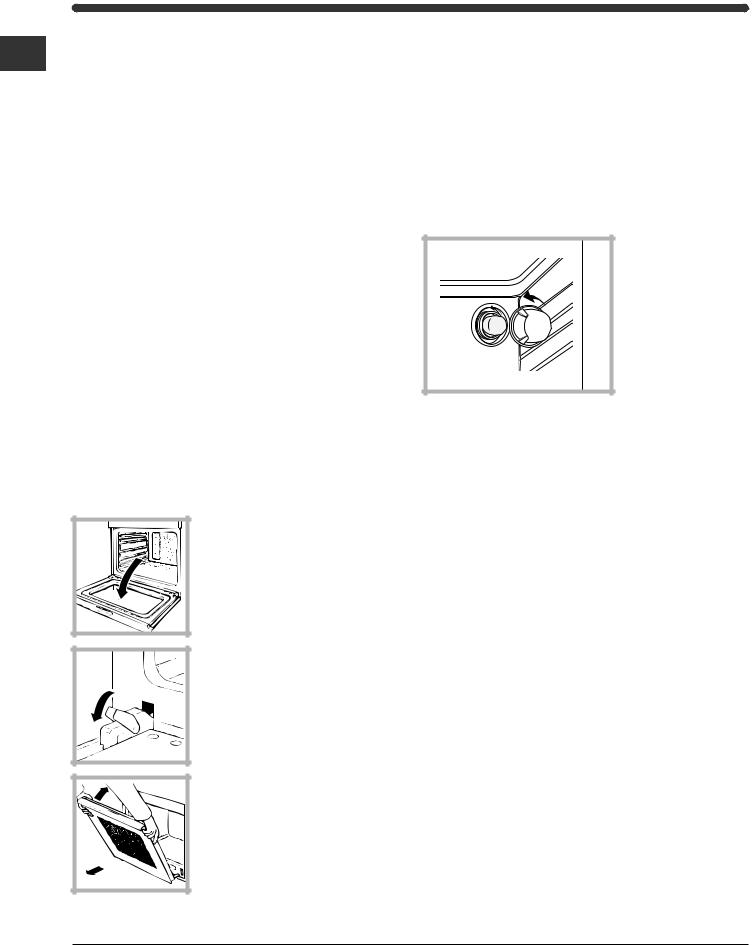
Manutenzione e cura
Escludere la corrente elettrica
IT
Prima di ogni operazione isolare l’apparecchio dalla rete di alimentazione elettrica.
Pulire l’apparecchio
•Le parti esterne smaltate o inox e le guarnizioni in gomma possono essere pulite con una spugnetta imbevuta di acqua tiepida, e sapone neutro. Se le macchie sono difficili da asportare usare prodotti specifici. Si consiglia di sciacquare abbondantemente e di asciugare dopo la pulizia. Non usare polveri abrasive o sostanze corrosive.
•L’interno del forno va pulito preferibilmente ogni volta dopo l’uso, quando è ancora tiepido. Usare acqua calda e detersivo, risciaquare e asciugare con un panno morbido. Evitare gli abrasivi.
•Gli accessori possono essere lavati come normali stoviglie, anche in lavastoviglie.
Pulire la porta
Pulire il vetro della porta con spugne e prodotti non abrasivi e asciugare con un panno morbido. Per una pulizia più accurata è possibile smontare la porta del forno:
1. aprire completamente la porta (vedi figura);
2. alzare e ruotare le levette poste sulle due cerniere (vedi figura);
3. afferrare la porta ai due lati esterni, richiudendola lentamente ma non del tutto. Poi tirare la porta verso di sé estraendola dalle cerniere (vedi figura).
Rimontare la porta seguendo il procedimento in senso contrario.
Controllare le guarnizioni
Controllare periodicamente lo stato della guarnizione attorno alla porta del forno. In caso risulti danneggiata rivolgersi al Centro Assistenza più vicino (vedi Assistenza). È consigliabile non usare il forno
fino all’avvenuta riparazione.
Sostituire la lampadina
Per sostituire la lampadina di illuminazione del forno:
1.Svitare il coperchio in vetro del portalampada.
2.Svitare la lampadina e sostituirla con una analoga: potenza 25 W, attacco E 14.
3.Rimontare il coperchio (vedi figura).
10

Assistenza
! Non ricorrere mai a tecnici non autorizzati.
IT
Comunicare:
•Il tipo di anomalia;
•Il modello della macchina (Mod.)
•Il numero di serie (S/N)
Queste ultime informazioni si trovano sulla targhetta caratteristiche posta sull’apparecchio
Assistenza attiva 7 giorni su 7 
In caso di necessità d’intervento chiamare il Numero Unico Nazionale 199.199.199*.
Un operatore sarà a completa disposizione per fissare un appuntamento con il Centro Assistenza Tecnico Autorizzato più vicino al luogo da cui si chiama.
È attivo 7 giorni su 7, sabato e domenica compresi, e non lascia mai inascoltata una richiesta.
*Al costo di 14,26 centesimi di Euro al minuto(iva inclusa) dal Lun. al Ven. dalle 08:00 alle 18:30, il Sab. dalle 08:00 alle 13:00 e di 5,58 centesimi di Euro al minuto (iva inclusa) dal Lun. al Ven. dalle 18:30 alle 08:00, il Sab. dalle 13:00 alle 08:00 e i giorni festivi, per chi chiama da telefono fisso.
Per chi chiama da radiomobile le tariffe sono legate al piano tariffario dell’operatore telefonico utilizzato.
Le suddette tariffe potrebbero essere soggette a variazione da parte dell’operatore telefonico; per maggiori informazioni consultare il sito www.indesit.com.
11

Operating Instructions
OVEN
GB
Contents
|
|
|
|
|
|
Installation, 13-14 |
|
IT |
|
GB |
|
FR |
|
||
|
|
|
Positioning |
||||
|
|
|
|
|
|
Electrical connections |
|
Italiano, 1 |
English,12 |
Français, 22 |
|||||
Data plate |
|||||||
ES |
|
PT |
|
NL |
|
|
|
|
|
|
|
Espanol, 32 |
Portuges, 42 |
Nederlands, 52 |
|||
|
|
|
|
|
|
DE |
|
|
|
|
|
|
|
|
|
|
|
Deutsch, 62 |
|
|
|
|
|
FI 51.B
FI 51.B IX
FI 51 K.B
FI 51 K.B IX
FI 56 K.B
FI 56 K.B IX
FI 56 KC.B
FI 56 KC.B IX
Description of the appliance, 15
Overall view Control panel
Start-up and use, 16
Starting the oven
How to use the timer
Cooking modes, 17-18
Cooking modes
Practical cooking advice
Cooking advice table
The electronic cooking programmer, 19
Precautions and tips, 20
General safety Disposal
Respecting and conserving the environment
Maintenance and care, 21
Switching the appliance off
Cleaning the appliance
Cleaning the oven door
Replacing the light bulb
Assistance
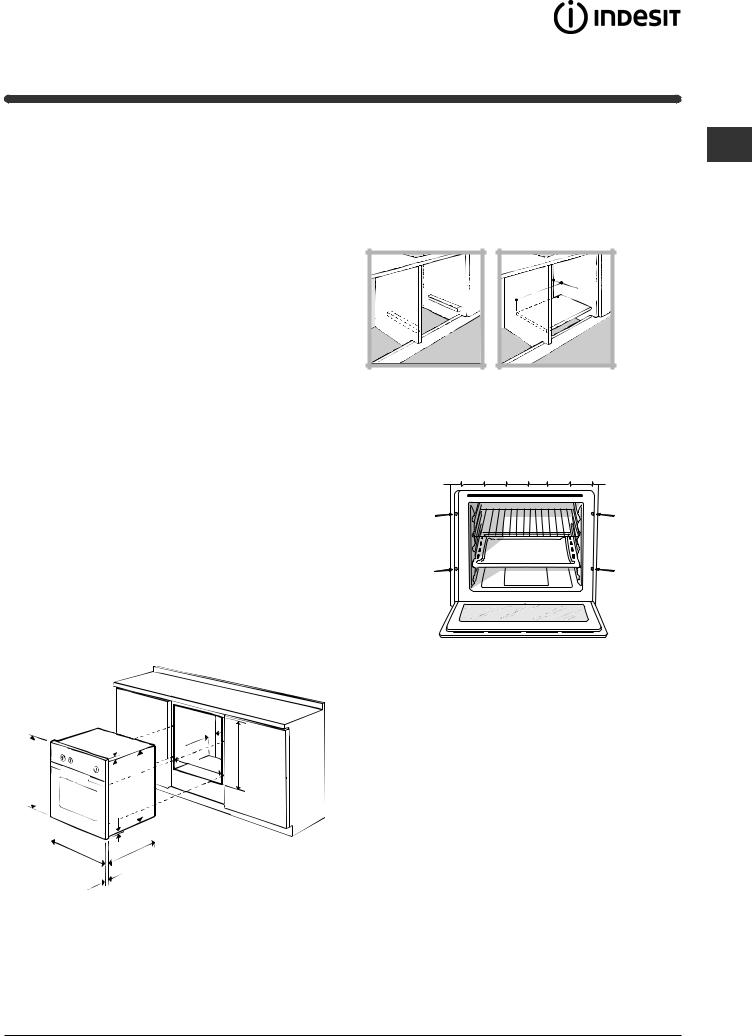
Installation
!Before placing your new appliance into operation please read these operating instructions carefully. They contain important information for safe use, for installation and for care of the appliance.
!Please keep these operating instructions for future reference. Pass them on to possible new owners of the appliance.
Positioning
!Keep packaging material out of the reach of children. It can become a choking or suffocation hazard. (see Precautions and tips).
!The appliance must be installed by a qualified person in compliance with the instructions provided. Incorrect installation may cause harm to persons, animals or may damage property.
Fitting the appliance
Use the appropriate cabinet to ensure that the appliance functions properly.
•The panels adjacent to the oven must be made of heat-resistant material.
•Cabinets with a veneer exterior must be assembled with glues which can withstand temperatures of up to 100°C.
•to install the oven under the counter (see diagram) and in a kitchen unit, the cabinet must have the following dimensions:
595 mm. |
23 mm. |
567 mm. |
|
|
5 mm. |
595 |
mm. |
|
. |
|
545 |
mm |
|
|
|
||
|
. |
|
|
|
mm |
|
|
24 |
|
|
|
|
|
. |
45 |
mm |
|
|
|
|
|
558 |
mm. |
|
|
|
593 mm.
! The appliance must not come into contact with electrical parts once it has been installed.
The consumption indications on the data plate have been calculated for this type of installation.
Ventilation
GB
To ensure good ventilation, the back panel of the cabinet must be removed. It is advisable to install the oven so that it rests on two strips of wood, or on a completely flat surface with an opening of at least 45 x 560 mm (see diagrams).
. |
45 |
mm |
. |
mm |
|
||
560 |
|
|
|
Centring and fastening
Secure the appliance to the cabinet by opening the oven door and putting 4 screws into the 4 holes of the outer frame.
! All parts which ensure the safe operation of the appliance must not be removable without the aid of a tool.
13
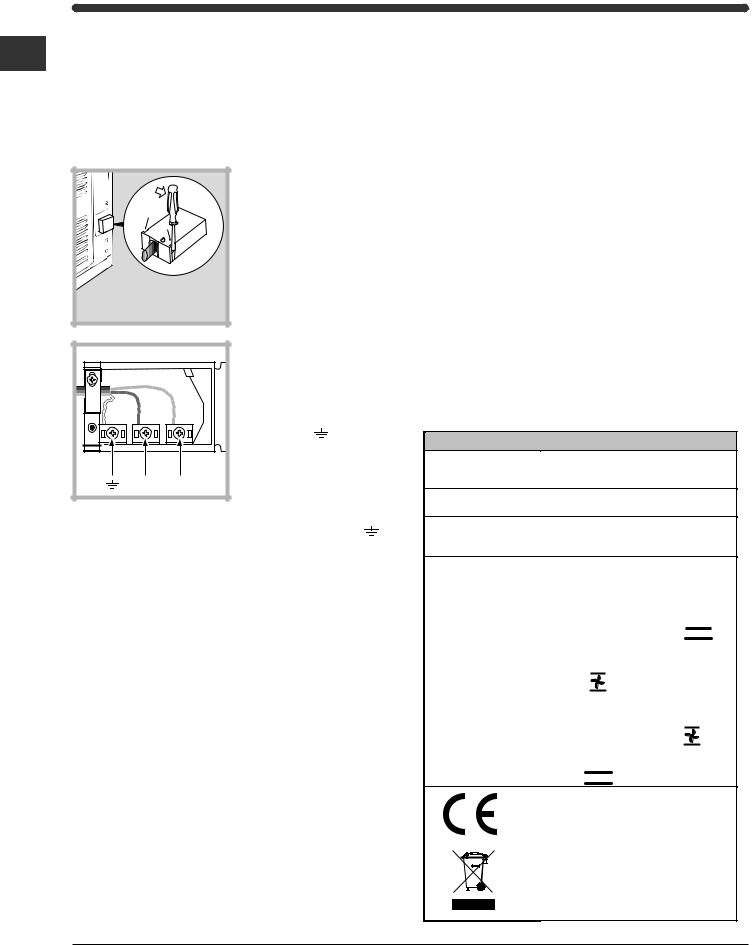
Electrical connections
GB
! Ovens equipped with a three-pole power supply cable are designed to operate with alternating current at the voltage and frequency indicated on the data plate located on the appliance (see below).
Fitting the power supply cable
1. Open the terminal board by inserting a screwdriver into the side tabs of the cover. Use the screwdriver as a lever by pushing it down to open the cover (see diagram).
|
|
2. Install the power |
|
|
|
supply cable by |
|
|
|
loosening the cable |
|
|
|
clamp screw and the |
|
|
|
three wire contact |
|
|
|
screws L-N- . Connect |
|
|
|
the wires to the |
|
|
|
corresponding |
|
N |
L |
terminals: the Blue wire |
|
to the terminal marked |
|||
|
|
||
|
|
(N), the Brown wire to |
|
the terminal marked (L) and the Yellow Green wire |
|||
to the terminal marked (see diagram). |
|||
3.Secure the cable by fastening the clamp screw.
4.Close the cover of the terminal board.
Connecting the supply cable to the mains
Install a standardised plug corresponding to the load indicated on the data plate (see side).
The appliance must be directly connected to the mains using an omnipolar circuit-breaker with a minimum contact opening of 3 mm installed between the appliance and the mains, suitable for the load indicated and complying with current electrical regulations (the earthing wire must not be interrupted by the circuit-breaker). The supply cable must not come into contact with surfaces with temperatures higher than 50°C.
! The installer must ensure that the correct electrical connection has been made and that it is compliant with safety regulations.
Before connecting to the power supply, make sure that:
•The appliance is earthed and the plug is compliant with the law.
•The socket can withstand the maximum power of the appliance, which is indicated on the data plate (see below).
•The voltage must be in the range between the values indicated on the data plate (see below).
•The socket is compatible with the plug of the appliance. If the socket is incompatible with the plug, ask an authorised technician to replace it. Do not use extension cords or multiple sockets.
!Once the appliance has been installed, the power supply cable and the electrical socket must be easily accessible.
!The cable must not be bent or compressed.
!The cable must be checked regularly and replaced by authorised technicians only (see Assistance).
!The manufacturer declines any liability should these safety measures not be observed.
D A T A P L A T E |
|
|
|
|
|
|
D im e n s io n s |
w id th cm 4 3 .5 |
|
|
|||
h e ig ht cm 32 |
|
|
||||
|
d e p th cm 4 0 |
|
|
|||
V o lu m e |
lt. 5 6 |
|
|
|
|
|
E le c tric a l |
vo lta g e : 2 2 0 -2 3 0 V ~ 5 0 /6 0 H z o r |
|||||
5 0 H z (se e d a ta p la te ) |
|
|||||
c o n n e c tio n s |
|
|||||
m a xim u m po w e r a b so rb e d 2 2 50W |
||||||
|
||||||
|
D ire ctive 2 0 02 /4 0 /E C o n th e la b el |
|||||
|
o f e le c tric o ven s . |
|
|
|||
|
S ta n d a rd E N 5 03 0 4 |
|
|
|||
|
M o d e ls w ith c o o lin g v e n tila tio n : |
|||||
|
E n e rg y con s um p tio n fo r N a tu ra l |
|||||
|
co n ve ctio n h e atin g m od e : |
|
||||
|
C o n ve ction |
|
|
|||
|
D e cla re d |
en e rg y co n su m ption fo r |
||||
E N E R G Y L A B E L |
F o rced |
co n ve ctio n |
C la ss |
h ea ting |
||
m o d e: |
|
M u lti-co o kin g |
||||
|
M o d e ls |
|
w ith o u t |
c o o lin g |
||
|
v e n tila tio n : |
|
|
|||
|
E n e rg y con s um p tio n fo r F orc e d |
|||||
|
co n ve ctio n h e atin g m od e : |
|
||||
|
M u lti-c o o kin g |
|
|
|||
|
D e cla re d en e rg y co n su m ption fo r |
|||||
|
N a tu ra l co n vection C lass h e atin g |
|||||
|
m o d e: |
|
C o n ve ctio n |
|
||
|
T h is a p plian ce con fo rm s to the |
|||||
|
fo llo w in g E u ro p ea n E co n om ic |
|||||
|
C o m m un ity dire c tive s : |
|
||||
|
7 3 /2 3 /E E C o f 19 /0 2 /7 3 (L o w |
|||||
|
V o lta ge ) a nd su b se q ue n t |
|
||||
|
a m e nd m en ts; |
|
|
|||
|
-8 9 /3 36 /E E C o f 0 3 /05 /8 9 |
|
||||
|
(E le c tro m ag n e tic C o m pa tibility) a n d |
|||||
|
su b se q ue n t a m en d m e n ts; |
|
||||
|
9 3 /6 8 /E E C o f 22 /0 7 /9 3 an d |
|
||||
|
su b se q ue n t a m en d m e n ts . |
|
||||
|
2 0 0 2 /9 6 /E C |
|
|
|||
14

Description of the appliance
Overall view
GB
Control panel |
GUIDES for the |
|
|
sliding racks |
|
GRILL |
position 5 |
|
|
position 4 |
|
DRIPPING PAN |
position 3 |
|
position 2 |
||
|
||
|
position 1 |
Control panel
|
|
|
|
|
|
|
SELECTOR |
|
TIMER |
Indicator light |
|
|
||||||||||||||
|
|
|
|
|
|
|
|
|
||||||||||||||||||
|
|
|
|
|
|
|
Knob |
|
knob* |
THERMOSTAT |
|
|
||||||||||||||
|
|
|
|
|
|
|
|
|
|
|
|
|
|
|
|
|
|
|
|
|
|
|
|
|
|
|
|
|
|
|
|
|
|
|
|
|
|
|
|
|
|
|
|
|
|
|
|
|
|
|
|
|
|
|
|
|
|
|
|
|
|
|
|
|
|
|
|
|
|
|
|
|
|
|
|
|
|
|
|
|
|
|
|
|
|
|
|
|
|
|
|
|
|
|
|
|
|
|
|
|
|
|
|
|
|
|
|
|
|
|
|
|
|
|
|
|
|
|
|
|
|
|
|
|
|
|
|
|
|
|
|
|
|
|
|
|
|
|
|
|
|
|
|
|
|
|
|
|
|
|
|
|
|
|
|
|
|
|
|
|
|
|
|
|
|
|
|
|
|
|
|
|
|
|
|
|
|
|
|
|
|
|
|
|
|
|
|
|
|
|
|
|
|
|
|
|
|
|
|
|
|
|
|
|
|
|
|
|
|
|
|
|
|
|
|
|
|
|
|
|
|
|
|
|
|
|
|
|
|
|
|
|
|
|
|
|
|
|
|
|
|
|
|
|
|
|
|
|
|
|
|
|
|
|
|
|
|
|
|
|
|
|
|
|
|
|
|
|
|
|
|
|
|
|
|
|
|
|
|
|
|
|
|
|
|
|
|
|
|
|
|
|
|
|
|
|
|
|
|
|
|
|
|
|
|
|
|
|
|
|
|
|
|
|
|
|
|
|
|
|
|
|
|
|
|
|
|
|
|
|
|
|
|
|
|
|
|
|
|
|
|
|
|
|
|
|
|
|
|
|
THERMOSTAT
Knob
|
|
|
|
|
|
|
SELECTOR |
|
|
|
|
ELECTRONIC |
Indicator light |
|
|
|||||||||||||||||
|
|
|
|
|
|
|
|
|
|
|
|
|||||||||||||||||||||
|
|
|
|
|
|
|
Knob |
|
|
|
|
programmer* |
THERMOSTAT |
|
|
|||||||||||||||||
|
|
|
|
|
|
|
|
|
|
|
|
|
|
|
|
|
|
|
|
|
|
|
|
|
|
|
|
|
|
|
|
|
|
|
|
|
|
|
|
|
|
|
|
|
|
|
|
|
|
|
|
|
|
|
|
|
|
|
|
|
|
|
|
|
|
|
|
|
|
|
|
|
|
|
|
|
|
|
|
|
|
|
|
|
|
|
|
|
|
|
|
|
|
|
|
|
|
|
|
|
|
|
|
|
|
|
|
|
|
|
|
|
|
|
|
|
|
|
|
|
|
|
|
|
|
|
|
|
|
|
|
|
|
|
|
|
|
|
|
|
|
|
|
|
|
|
|
|
|
|
|
|
|
|
|
|
|
|
|
|
|
|
|
|
|
|
|
|
|
|
|
|
|
|
|
|
|
|
|
|
|
|
|
|
|
|
|
|
|
|
|
|
|
|
|
|
|
|
|
|
|
|
|
|
|
|
|
|
|
|
|
|
|
|
|
|
|
|
|
|
|
|
|
|
|
|
|
|
|
|
|
|
|
|
|
|
|
|
|
|
|
|
|
|
|
|
|
|
|
|
|
|
|
|
|
|
|
|
|
|
|
|
|
|
|
|
|
|
|
|
|
|
|
|
|
|
|
|
|
|
|
|
|
|
|
|
|
|
|
|
|
|
|
|
|
|
|
|
|
|
|
|
|
|
|
|
|
|
|
|
|
|
|
|
|
|
|
|
|
|
|
|
|
|
|
|
|
|
|
|
|
|
|
|
|
|
|
|
|
|
|
|
|
|
|
|
|
|
|
|
|
|
|
|
|
|
|
|
|
|
|
|
|
|
|
|
|
|
|
|
|
|
|
|
|
|
|
|
|
|
|
|
|
|
|
|
|
|
|
|
|
|
|
|
|
THERMOSTAT
Knob
* Only on certain models
15

Start-up and use
! The first time you use your appliance, heat the empty GB oven with its door closed at its maximum temperature
for at least half an hour. Ensure that the room is well ventilated before switching the oven off and opening the oven door. The appliance may produce a slightly unpleasant odour caused by the burning away of protective substances used during the manufacturing process.
Starting the oven
1.Select the desired cooking mode by turning the SELECTOR knob.
2.Select the desired temperature with the THERMOSTAT knob. See the Cooking advice table for cooking modes and the suggested cooking temperatures (see Cooking Modes).
3.When preheating is finished, the THERMOSTAT indicator light will stay on: place the food in the oven.
4.You may do the following during cooking:
-change the cooking mode by turning the SELECTOR knob.
-change the temperature by turning the THERMOSTAT knob.
-stop cooking by turning the SELECTOR knob to the “0” position.
! Should the appliance be equipped with an electronic programmer, to use the electric oven, just press button (the symbol m will appear on the display) before selecting the desired cooking function.
!Never put objects directly on the oven bottom to avoid damaging the enamel coating.
!Always place cookware on the rack(s) provided.
Cooling ventilation
In order to cool down the external temperature of the oven, some models are fitted with a cooling fan that blows out air between the control panel and the oven door.
! Once the cooking has been completed, the cooling fan remains on until the oven has cooled down sufficiently.
Oven light
It goes on when selecting  with the SELECTOR knob. It stays on when a cooking mode is selected.
with the SELECTOR knob. It stays on when a cooking mode is selected.
How to use the timer*
1.To set the buzzer, turn the TIMER knob clockwise almost one complete revolution.
2.Turn the knob anticlockwise to set the desired time: align the minutes shown on the knob with the indicator on the control panel.
3.The timer operates in minutes: when the selected time has elapsed, a buzzer will sound.
! The timer does not turn the oven on or off.
* Only on certain models
16
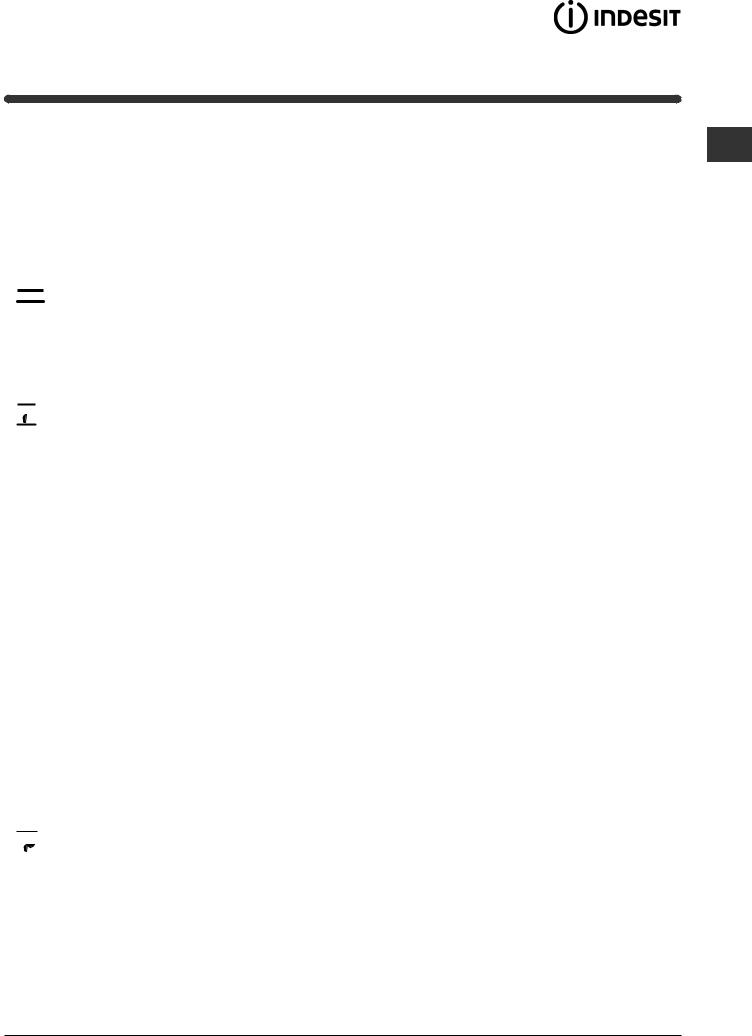
Cooking modes
Cooking modes
! A temperature value can be set for all cooking modes between 60°C and Max, except for
•GRILL (recommended: set only to MAX power level);
•GRATIN (recommended: do not exceed 200°C).
TRADITIONAL OVEN mode
Both the top and bottom heating elements will come on. With this traditional cooking mode, it is best to use one cooking rack only; if more than one rack is used, the heat will be distributed unevenly.
 MULTI-COOKING mode
MULTI-COOKING mode
All the heating elements (top and bottom), as well as the fan, will come on. Since the heat remains constant throughout the oven, the air cooks and browns food uniformly. A maximum of two racks may be used at the same time.


 TOP OVEN mode
TOP OVEN mode
The top heating element comes on. This mode can be used to brown food at the end of cooking.



 GRILL mode
GRILL mode
The top heating element comes on. The extremely high and direct temperature of the grill makes it possible to brown the surface of meats and roasts while locking in the juices to keep them tender. The grill is also highly recommended for dishes that require a high temperature on the surface: such as beef steaks, veal, rib steak, filets, hamburgers etc...
Some grilling examples are included in the “Practical Cooking Advice” paragraph. Always cook in this mode with the oven door closed.

 GRATIN mode
GRATIN mode
The top heating element, as well as the fan, will come on. This combination of features increases the effectiveness of the unidirectional thermal radiation of the heating elements through forced circulation of the air throughout the oven. This helps prevent food from burning on the surface, allowing the heat to penetrate right into the food. Always cook in this mode with the oven door closed.
Practical cooking advice
GB
!Do not place racks in position 1 and 5 during fanassisted cooking. Excessive direct heat can burn temperature sensitive foods.
!In the GRILL and GRATIN cooking modes, place the dripping pan in position 1 to collect cooking residues (fat and/or grease).
MULTI-COOKING
•Use position 2 and 4, placing the food that requires more heat on 2.
•Place the dripping pan on the bottom and the rack on top.
GRILL
•Insert the rack in position 3 or 4. Place the food in the centre of the rack.
•We recommend that you set the maximum power level. The top heating element is regulated by a thermostat and may not always be on.
PIZZA
•For best results when cooking pizza, use the MULTI-COOKING mode.
•Use a light aluminium pizza pan. Place it on the rack provided.
For a crispy crust, do not use the dripping pan (prevents crust from forming by extending cooking time).
•If the pizza has a lot of toppings, we recommend adding the mozzarella cheese on top of the pizza halfway through the cooking process.
17

|
|
|
|
|
|
|
|
|
|
|
Cooking advice table |
|
|
|
|
|
|
||
GB |
|
|
|
|
|
|
|||
|
|
|
|
|
|
|
|
|
|
|
|
|
|
|
|
|
|
|
|
|
|
|
|
|
|
|
|
|
|
|
|
Cooking |
|
Weight |
Rack |
Pre- |
Recommended |
Cooking |
|
|
|
Foods |
heating |
time |
|
||||
|
|
modes |
(in kg) |
position |
temperature |
|
|||
|
|
|
time (min) |
(minutes) |
|
||||
|
|
|
|
|
|
|
|
||
|
|
|
Duck |
1 |
3 |
15 |
200 |
65-75 |
|
|
|
Convection |
Roast veal or beef |
1 |
3 |
15 |
200 |
70-75 |
|
|
|
Pork roast |
1 |
3 |
15 |
200 |
70-80 |
|
|
|
|
Oven |
|
||||||
|
|
Biscuits (short pastry) |
- |
3 |
15 |
180 |
15-20 |
|
|
|
|
|
|
||||||
|
|
|
Tarts |
1 |
3 |
15 |
180 |
30-35 |
|
|
|
|
Pizza (on 2 racks) |
1 |
2 and 4 |
15 |
230 |
15-20 |
|
|
|
|
Lasagne |
1 |
3 |
10 |
180 |
30-35 |
|
|
|
|
Lamb |
1 |
2 |
10 |
180 |
40-45 |
|
|
|
|
Roast chicken + potatoes |
1+1 |
2 and 4 |
15 |
200 |
60-70 |
|
|
|
Multi-cooking |
Mackerel |
1 |
2 |
10 |
180 |
30-35 |
|
|
|
Plum cake |
1 |
2 |
10 |
170 |
40-50 |
|
|
|
|
|
Cream puffs (on 2 racks) |
0.5 |
2 and 4 |
10 |
190 |
20-25 |
|
|
|
|
Biscuits (on 2 racks) |
0.5 |
2 and 4 |
10 |
180 |
10-15 |
|
|
|
|
Sponge cake (on 1 rack) |
0.5 |
2 |
10 |
170 |
15-20 |
|
|
|
|
Sponge cake (on 2 racks) |
1 |
2 and 4 |
10 |
170 |
20-25 |
|
|
|
|
Savoury pies |
1.5 |
3 |
15 |
200 |
25-30 |
|
|
|
Top oven |
Browning food to perfect cooking |
- |
3/4 |
15 |
220 |
- |
|
|
|
|
|
|
|
|
|
|
|
|
|
|
Soles and cuttlefish |
1 |
4 |
5 |
Max |
8-10 |
|
|
|
|
Squid and prawn kebabs |
1 |
4 |
5 |
Max |
6-8 |
|
|
|
|
Cod filet |
1 |
4 |
5 |
Max |
10 |
|
|
|
Grill |
Grilled vegetables |
1 |
3 or 4 |
5 |
Max |
10-15 |
|
|
|
Veal steak |
1 |
4 |
5 |
Max |
15-20 |
|
|
|
|
|
Cutlets |
1 |
4 |
5 |
Max |
15-20 |
|
|
|
|
Hamburgers |
1 |
4 |
5 |
Max |
7-10 |
|
|
|
|
Mackerels |
1 |
4 |
5 |
Max |
15-20 |
|
|
|
|
Toasts |
4 |
4 |
5 |
Max |
2-3 |
|
|
|
Gratin |
Grilled chicken |
1.5 |
2 |
5 |
200 |
55-60 |
|
|
|
Cuttlefish |
1.5 |
2 |
5 |
200 |
30-35 |
|
|
|
|
|
|
||||||
18

The electronic cooking programmer
This feature allows you to program the oven or the grill as follows:
•delayed cooking time for a specified period;
•immediate start for a specified period;
•timer.
Button Functions:
 : Timer with hours and minutes;
: Timer with hours and minutes;
 : cooking time;
: cooking time;

 : end cooking time;
: end cooking time;
:Manual change;
:set cooking time (to count down);
 : set cooking time (to start from zero)
: set cooking time (to start from zero)
How to reset the digital clock
After the appliance has been connected to the power supply, or after a power cut, the clock display will automatically reset to 0:00 and begin to blink.
•Press the  and
and 
 buttons consecutively and then reset the time (within 4 seconds) using the
buttons consecutively and then reset the time (within 4 seconds) using the
and  buttons.
buttons.
The button advances the hours.
The button decreases the hours.
The time can also be changed in the following two
ways: |
|
|
|
1. |
Repeat all of the steps above. |
|
|
2. |
Press the button, and then use the |
|
and |
|
buttons to reset the time. |
|
|
Manual operation of the oven
Once the time has been set, the programmer automatically switches to manual mode.
Note: Press the button to restore the manual mode after every “Automatic” cooking session.
Delayed cooking time for a specified period
The total cooking time as well as the time at which the cooking will finish must be set. If we assume that the time display reads10:00:
1.Turn the oven control knob to the setting and temperature desired (example: static oven mode at 200°C).
2.Press the button  and then set the cooking time
and then set the cooking time
(within four seconds) using the |
|
and |
|
|
|
buttons. |
Supposing the cooking time is set to 30 minutes, the |
||||||
display will read as follows: |
|
|
|
|
|
|
+ |
|
|
|
|
|
|
Release the button, and within 4 seconds, the current time will reappear with the m symbol along with the word “auto” 3. Press the button 
 and then use the and
and then use the and  buttons to set the time for when the cooking program
buttons to set the time for when the cooking program
should end. Let us imagine this time to be 1:00 p.m.
=
4.After the button has been released, the current time will be displayed after approximately 4 seconds:
? GB
When “auto” is on, it indicates that the length of cooking time and the time it is due to finish have been programmed in automatic mode. At this point, the oven will turn on automatically at 12:30 and turn off after 30 minutes. When the oven is turned on, the symbol m will be displayed for the entire cooking time. The cooking duration can be displayed at any time by
pressing the button |
|
|
, and the time it is due to finish |
||
|
|
||||
|
|
||||
may be displayed by pressing the button |
|
. |
|||
|
|||||
Once cooking is completed, the timer will ring; to turn
it off, simply press any button except the |
|
and |
buttons. |
|
|
Immediate start for a specified period
By programming just the duration (points 1 and 2 of the “Delayed cooking time for specified period” section), cooking will begin immediately.
To cancel a cooking schedule already programmed
Press the |
|
|
button, and use the |
|
button to set the |
|
|
||||
time to: |
, |
|
|
||
|
|
|
|||
then press the manual cooking mode button  .
.
Timer Feature
The timer feature allows you to enter a specific amount of time and begins to count down. This feature does not turn the oven on or off; it merely sounds when the time has elapsed.
When the button |
has been pressed, the display will |
||||||
read as follows: |
, |
||||||
Then use the |
|
|
|
and |
|
|
buttons to set the desired time. |
As soon as the |
|
button has been released, the timer will |
|||||
start to count down and the current time will be
displayed.
.
After the time has expired, an audible signal will be emitted, which can be turned off by pressing any button (except the  and buttons). At this point the symbol
and buttons). At this point the symbol
 will also turn off.
will also turn off.
Correction/Cancellation of data
•The data entered can be changed at any time by
pressing the corresponding button and the  or buttons.
or buttons.
•When the data for the cooking duration is cancelled, the data for the time cooking is due to end is also cancelled automatically, and vice versa.
•If the oven has already been programmed, it will not accept times for the end of cooking which are before the start of the programmed cooking process.
19

Precautions and tips
! The appliance was designed and manufactured in GB compliance with international safety standards. The
following warnings are provided for safety reasons and must be read carefully.
General safety
•The appliance was designed for domestic use inside the home and is not intended for commercial or industrial use.
•The appliance must not be installed outdoors, even in covered areas. It is extremely dangerous to leave the appliance exposed to rain and storms.
•When handling the appliance, always use the handles provided on the sides of the oven.
•Do not touch the appliance with bare feet or with wet or moist hands and feet.
•The appliance must be used to cook food by adults only and according to the instructions in this manual.
•When the appliance is in use, the heating elements and some parts of the oven door become extremely hot. Make sure you don't touch them and keep children well away.
•Ensure that the power supply cable of other electrical appliances does not come into contact with the hot parts of the oven.
•The openings used for ventilation and dispersion of heat must never be covered.
•Always grip the oven door handle in the centre: the ends may be hot.
•Always use oven gloves to place cookware in the oven or when removing it.
•Do not use aluminium foil to line the bottom of the oven.
•Do not place flammable materials in the oven: if the appliance is switched on by mistake, it could catch fire.
•Always make sure the knobs are in the “l”/“¡” position when the appliance is not in use.
•When unplugging the appliance always pull the plug from the mains socket, do not pull on the cable.
•Never carry out any cleaning or maintenance work without having unplugged the plug from the mains.
•In the case of a malfunction, under no circumstances should you attempt to repair the appliance yourself. Repairs carried out by inexperienced persons may cause injury or further malfunctioning of the appliance. Contact a Service Centre (see Assistance).
•Do not rest heavy objects on the open oven door.
Disposal
•Observe local environmental standards when disposing packaging material for recycling purposes. Observe existing legislation when disposing of the old appliance.
•The European Directive 2002/96/EC on Waste Electrical and Electronic Equipment (WEEE), requires that old household electrical appliances must not be disposed of in the normal unsorted municipal waste stream. Old appliances must be collected separately in order to optimise the recovery and recycling of the materials they contain and reduce the impact on human health and the environment. The crossed out “wheeled bin” symbol on the product reminds you of your obligation, that when you dispose of the appliance it must be separately collected.
Consumers should contact their local authority or retailer for information concerning the correct disposal of their old appliance.
Respecting and conserving the environment
•By using the appliance in the hours between late afternoon and early morning, you can help reduce the work load placed on electrical companies.
•Always keep the oven door closed when using the GRILL and GRATIN mode to attain best results and to save energy (approximately 10%).
•Regularly check the door seals and wipe clean to ensure they are free of debris so that they stick properly to the door and do not allow heat to disperse.
20
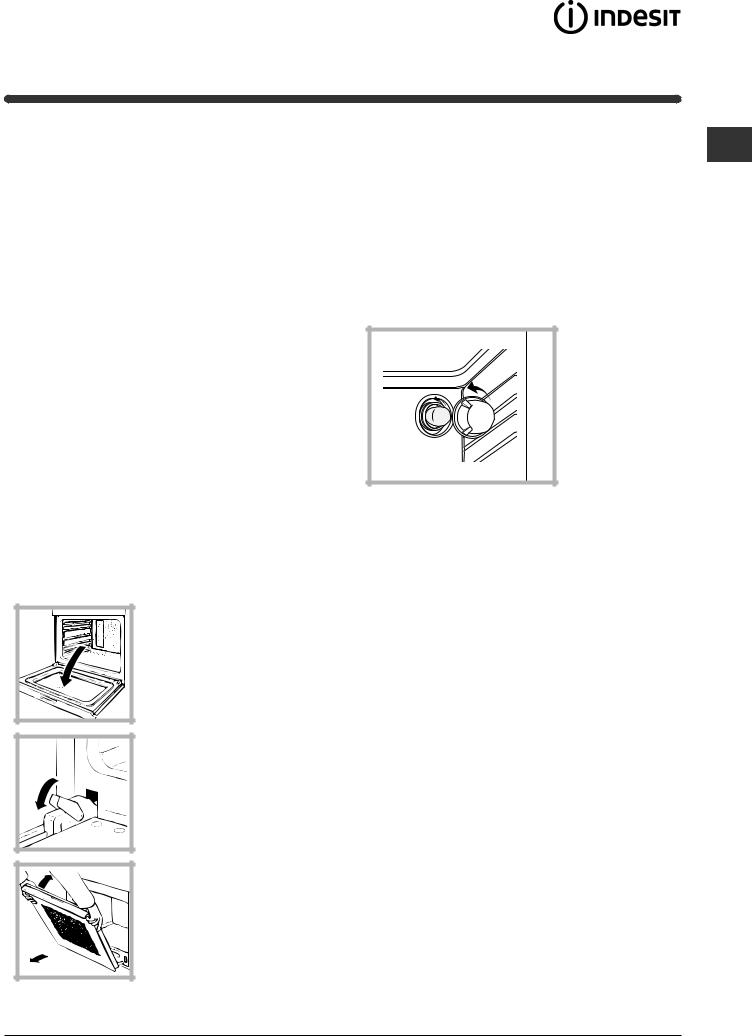
Maintenance and care
Switching the appliance off
Disconnect your appliance from the electricity supply before carrying out any work on it.
Cleaning the appliance
•The stainless-steel or enamel-coated external parts as well as the rubber seals may be cleaned using a sponge that has been soaked in lukewarm water and neutral soap. If these stains are difficult to remove, use only specialised products. After cleaning, rinse and dry thoroughly. Do not use abrasive powders or corrosive substances.
•Ideally, the inside of the oven should be cleaned after each use, when it is still lukewarm. Use hot water and detergent, rinse and dry with a soft cloth. Do not use abrasive products.
•The accessories can be washed like everyday crockery (even in your dishwasher).
Cleaning the oven door
Clean the glass door using non-abrasive products and sponges and dry it with a soft cloth.
To clean more thoroughly, you can remove the oven door.
1. Open the oven door fully (see diagram)
2. Lift up and turn the small levers located on the two hinges (see diagram)
3. Grip the door on the two external sides and close it approximately half way. Then pull the door towards you lifting it out of its seat (see diagram). To replace the door, reverse this sequence.
Inspecting the seals
GB
Check the door seals around the oven periodically. If the seals are damaged, please contact your nearest After-sales Service Centre (see Assistance). We recommend not using the oven until the seals have been replaced.
Replacing the light bulb
To replace the oven light bulb:
1.Remove the glass cover of the lamp-holder.
2.Remove the light bulb and replace it with a similar one: Wattage 25 W, cap E 14.
3.Replace the glass cover (see diagram).
Assistance
Communicating:
•appliance model (Mod.)
•serial number (S/N)
This information is found on the data plate located on the appliance and/or on the packaging.
21

Mode d’emploi
FR
IT |
|
GB |
|
|
FR |
|
|
|
|
|
|
|
|
Italiano, 1 |
English,12 |
Français, 22 |
||||
|
|
|
|
|
|
|
ES |
|
PT |
|
NL |
|
|
|
|
|
|
|
|
|
Espanol, 32 |
Portuges, 42 |
Nederlands, 52 |
||||
DE
Deutsch, 62
FI 51.B
FI 51.B IX
FI 51 K.B
FI 51 K.B IX
FI 56 K.B
FI 56 K.B IX
FI 56 KC.B
FI 56 KC.B IX
FOUR
Sommaire
Installation, 23-24
Positionnement
Raccordement électrique
Plaquette signalétique
Description de l’appareil, 25
Vue d’ensemble
Tableau de bord
Mise en marche et utilisation, 26
Mise en marche du four
Utilisation du minuteur
Programmes, 27-28
Programmes de cuisson
Conseils de cuisson
Tableau de cuisson
Le programmateur de cuisson électronique, 29
Précautions et conseils, 30
Sécurité générale
Mise au rebut
Economies et respect de l’environnement
Nettoyage et entretien, 31
Mise hors tension
Nettoyage de l’appareil
Nettoyage de la porte
Remplacement de l’ampoule d’éclairage
Assistance
